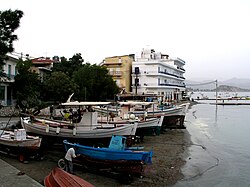Tolo
|
Tolo district Δημοτική Κοινότητα Τολού (Τολό) |
||
|---|---|---|
|
|
||
| Basic data | ||
| Country |
|
|
| region | Peloponnese | |
| Regional district | Argolis | |
| local community | Nafplio | |
| Parish | Asini | |
| Geographic coordinates | 37 ° 31 ' N , 22 ° 52' E | |
| Height above d. M. |
13 m |
|
| surface | 23.275 km² | |
| Residents | 1494 (2011) | |
| Population density | 64.19 inhabitants / km² | |
| LAU-1 code no. | 41010205 | |
| Local division | 2 settlements, 2 uninhabited islands |
|
| port | ||
Tolo ( Greek Τολό ( n. Sg. ), Outdated spelling: Tolon) is a fishing, bathing and tourist resort on the Peloponnese , about 10 km southeast of Nafplio , the first capital of Greece. The bay of Tolo as part of the Argolic Gulf is bordered to the east by the island of Romvi.
Tolo is a municipality in the municipality of Nafplio , municipality of Asini . The population was 1,494 people at the 2011 census. Besides the small town of Tolo itself, the hamlet of Agios Andonios (Άγιος Αντώνιος, 34 Ew.) And the two uninhabited islands Daskaleio and Koronisi belong to Tolo.
history
Tolo's history doesn't begin until 1830, but the surrounding history goes back much further: Asine in Tolo Bay was first described by Homer in the Iliad as one of the cities whose fleet took part in the Trojan War . In the centuries that followed, the bay of Tolo was repeatedly used as a refuge for warships. In the Byzantine period, Tolo was also a port of refuge for Nauplia.
During the time of the Crusades and the fall of the Byzantine Empire (1204), the area came under Frankish rule together with the rest of the Peloponnese until 1389, then it was taken over by the Venetians , and in 1540 it fell to the Ottomans .
In the fight against Ottoman rule, the Venetians, Germans and Poles allied and appointed Vice Admiral Francesco Morosini as Commander in Chief of the United Armed Forces. From July 1686, the bay of Tolo, which was then called Porto di Rogdi , formed the base of operations for his ships for this fight and provided space for the field camps. A harbor was built called Port d'Aulon or Port Talon and the fortifications that are still visible today were built on Romvi. The ancient walls of Asine were rebuilt and the island of Daskaleio was fortified with walls. It was possible to drive out the Ottomans and liberate Nauplia. But in 1715 the fortifications were destroyed by the Turks and in 1718 the area was recaptured.
Monuments of this time are the small church called Koimisis tis Theotokou (Κοίμησης της Θεοτόκου = Assumption of the Virgin ) built in 1688 on the island of Daskaleio, and the ruins of the fortress and of houses and cisterns on the island of Romvi in the bay of Tolo. During the Turkish occupation, people lived in constant terror. The Kryfo Scholeio (κρυφό σχολείο = Hidden School) on Daskaleio (Δασκαλειό = educational establishment) reminds that the children were secretly taught their national language and history here.
With the revolution of the Greek nation in 1821, Nafplio became the first capital of Greece and from here the Greek states still under Turkish rule were supported. With the decision of Ioannis Kapodistrias in 1831, a resettlement of immigrants from Crete in the bay, who had fled from the Egyptian viceroy Muhammad Ali Pasha , the conqueror, began.
In 1834 a new city was founded in the bay of Tolo by royal decree, which was named Minoa (Μινώα) after the legendary King Minos of Crete. Although Crete was liberated from foreign rule in 1898 and became Greek again in 1913, many former refugees stayed here and gave rise to the picturesque fishing village, which was finally renamed Tolo in 1916.
Due to its location, the natural beauty of the landscape and the proximity to the neighboring archaeological sites (such as Corinth , Mycenae , Tiryns and the famous sanctuary of Epidaurus ), economic growth began in this region in the 20th century. Tolo has developed into a popular holiday destination for tourists from all over the world, which is why there are more than 17 hotels ( as of 2008 ) and numerous restaurants.
Web links
literature
- Richard Speicher: Peloponnese. 2nd Edition. W. Kohlhammer, Stuttgart / Berlin / Cologne 1980, ISBN 3-17-010031-9 , pp. 179-180.
Individual evidence
- ↑ National Statistical Service of Greece (ΕΣΥΕ) according to the 2001 census , p. 49 (PDF, 793 kB)
- ↑ Results of the 2011 census, Greek Statistical Office (ΕΛ.ΣΤΑΤ) ( Memento from June 27, 2015 in the Internet Archive ) (Excel document, 2.6 MB)
- ↑ Homer: Iliad , 2, 560
- ↑ Petros Sara Takis: Argolida, Churches & Monasteries. A humble pilgrimage in sacred places. Athens 2007, ISBN 978-960-91420-4-5 , pp. 109-110


